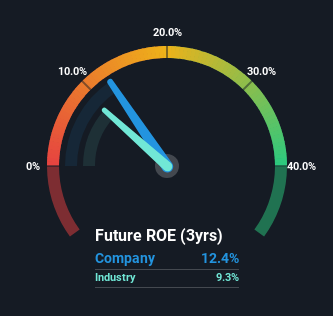A Closer Look At The Southern Company's (NYSE:SO) Impressive ROE
A Closer Look At The Southern Company's (NYSE:SO) Impressive ROE
Many investors are still learning about the various metrics that can be useful when analysing a stock. This article is for those who would like to learn about Return On Equity (ROE). By way of learning-by-doing, we'll look at ROE to gain a better understanding of The Southern Company (NYSE:SO).
許多投資者仍在學習在分析股票時可能有用的各種指標。本文是爲那些希望學習股本回報率(ROE)的人準備的。通過實踐學習,我們將查看ROE,以更好地理解南方公司(紐交所:SO)。
ROE or return on equity is a useful tool to assess how effectively a company can generate returns on the investment it received from its shareholders. In other words, it is a profitability ratio which measures the rate of return on the capital provided by the company's shareholders.
ROE或股本回報率是一個有用的工具,用於評估公司如何有效地產生來自股東投資的回報。換句話說,這是一種盈利能力比率,測量公司股東提供的資本的回報率。
How To Calculate Return On Equity?
如何計算股東權益回報率?
The formula for ROE is:
ROE的公式是:
Return on Equity = Net Profit (from continuing operations) ÷ Shareholders' Equity
股東權益回報率 = 淨利潤(來自持續運營)÷ 股東權益
So, based on the above formula, the ROE for Southern is:
因此,根據上述公式,南方公司的ROE爲:
12% = US$4.6b ÷ US$37b (Based on the trailing twelve months to September 2024).
12% = 46億美金 ÷ 370億美金(基於截至2024年9月的最近十二個月)。
The 'return' is the income the business earned over the last year. One way to conceptualize this is that for each $1 of shareholders' capital it has, the company made $0.12 in profit.
'回報'是企業在過去一年中獲得的收入。一種概念化的方式是,對於每1美元的股東資本,公司賺取了0.12美元的利潤。
Does Southern Have A Good Return On Equity?
南方電力公司的淨利潤回報率好嗎?
By comparing a company's ROE with its industry average, we can get a quick measure of how good it is. Importantly, this is far from a perfect measure, because companies differ significantly within the same industry classification. Pleasingly, Southern has a superior ROE than the average (9.3%) in the Electric Utilities industry.
通過將公司的ROE與其行業平均水平進行比較,我們可以快速衡量其表現。重要的是,這遠非一個完美的衡量標準,因爲同一行業分類內的公司有很大差異。令人滿意的是,南方電力公司的ROE優於電力公用股行業的平均水平(9.3%)。

That's what we like to see. However, bear in mind that a high ROE doesn't necessarily indicate efficient profit generation. A higher proportion of debt in a company's capital structure may also result in a high ROE, where the high debt levels could be a huge risk . Our risks dashboardshould have the 3 risks we have identified for Southern.
這正是我們所希望看到的。然而,請記住,高ROE並不一定表示高效的利潤生成。在公司的資本結構中,高債務比例也可能導致高ROE,而高債務水平可能是一個巨大風險。我們的風險儀表板應該包含我們爲南方電力識別出的3個風險。
How Does Debt Impact Return On Equity?
債務如何影響淨利潤回報率?
Most companies need money -- from somewhere -- to grow their profits. That cash can come from retained earnings, issuing new shares (equity), or debt. In the first and second cases, the ROE will reflect this use of cash for investment in the business. In the latter case, the debt used for growth will improve returns, but won't affect the total equity. That will make the ROE look better than if no debt was used.
大多數公司需要資金——從某個地方——來增長其利潤。這筆資金可以來自留存收益、發行新股(權益)或債務。在前兩種情況下,ROE將反映這種用於業務投資的現金使用。在後者的情況下,用於增長的債務會提高回報,但不會影響總權益。這將使ROE看起來比不使用債務時更好。
Combining Southern's Debt And Its 12% Return On Equity
將南方的負債與其12%的淨資產收益率結合起來
It's worth noting the high use of debt by Southern, leading to its debt to equity ratio of 1.72. Its ROE is quite low, even with the use of significant debt; that's not a good result, in our opinion. Debt does bring extra risk, so it's only really worthwhile when a company generates some decent returns from it.
值得注意的是南方高額的債務使用,導致其負債與權益比率爲1.72。儘管使用了大量債務,其ROE仍然相當低;在我們看來,這並不是一個好結果。債務確實帶來額外風險,因此只有在公司能從中產生可觀回報時,這種做法才真正有價值。
Conclusion
結論
Return on equity is useful for comparing the quality of different businesses. Companies that can achieve high returns on equity without too much debt are generally of good quality. If two companies have around the same level of debt to equity, and one has a higher ROE, I'd generally prefer the one with higher ROE.
淨資產收益率對於比較不同業務的質量非常有用。能夠在不使用過多債務的情況下實現高淨資產收益率的公司通常具有良好質量。如果兩家公司負債與權益的水平相近,而其中一家擁有更高的ROE,我通常會傾向於選擇ROE更高的那一家公司。
But ROE is just one piece of a bigger puzzle, since high quality businesses often trade on high multiples of earnings. The rate at which profits are likely to grow, relative to the expectations of profit growth reflected in the current price, must be considered, too. So you might want to take a peek at this data-rich interactive graph of forecasts for the company.
但是ROE只是更大拼圖中的一部分,因爲高質量的企業往往以高倍數的收益進行交易。必須考慮到相對於當前價格中反映的利潤增長預期,利潤可能增長的速度。因此,您可能想看一下該公司的預測數據豐富的互動圖表。
If you would prefer check out another company -- one with potentially superior financials -- then do not miss this free list of interesting companies, that have HIGH return on equity and low debt.
如果你更願意查看另一家公司——一家潛在的財務狀況優秀的公司——那麼一定不要錯過這份有趣公司的免費列表,這些公司有高股本回報率和低負債。
Have feedback on this article? Concerned about the content? Get in touch with us directly. Alternatively, email editorial-team (at) simplywallst.com.
This article by Simply Wall St is general in nature. We provide commentary based on historical data and analyst forecasts only using an unbiased methodology and our articles are not intended to be financial advice. It does not constitute a recommendation to buy or sell any stock, and does not take account of your objectives, or your financial situation. We aim to bring you long-term focused analysis driven by fundamental data. Note that our analysis may not factor in the latest price-sensitive company announcements or qualitative material. Simply Wall St has no position in any stocks mentioned.
對本文有反饋?對內容有疑慮?請直接與我們聯繫。或者,發送電子郵件至 editorial-team (at) simplywallst.com。
這篇來自Simply Wall St的文章是一般性的。我們根據歷史數據和分析師預測提供評論,採用無偏見的方法,我們的文章並不旨在提供財務建議。它不構成對任何股票的買入或賣出建議,也未考慮到您的目標或財務狀況。我們旨在爲您提供以基本數據驅動的長期分析。請注意,我們的分析可能未考慮最新的價格敏感公司公告或定性材料。Simply Wall St在提到的任何股票中均沒有持倉。

 Return on Equity = Net Profit (from continuing operations) ÷ Shareholders' Equity
Return on Equity = Net Profit (from continuing operations) ÷ Shareholders' Equity